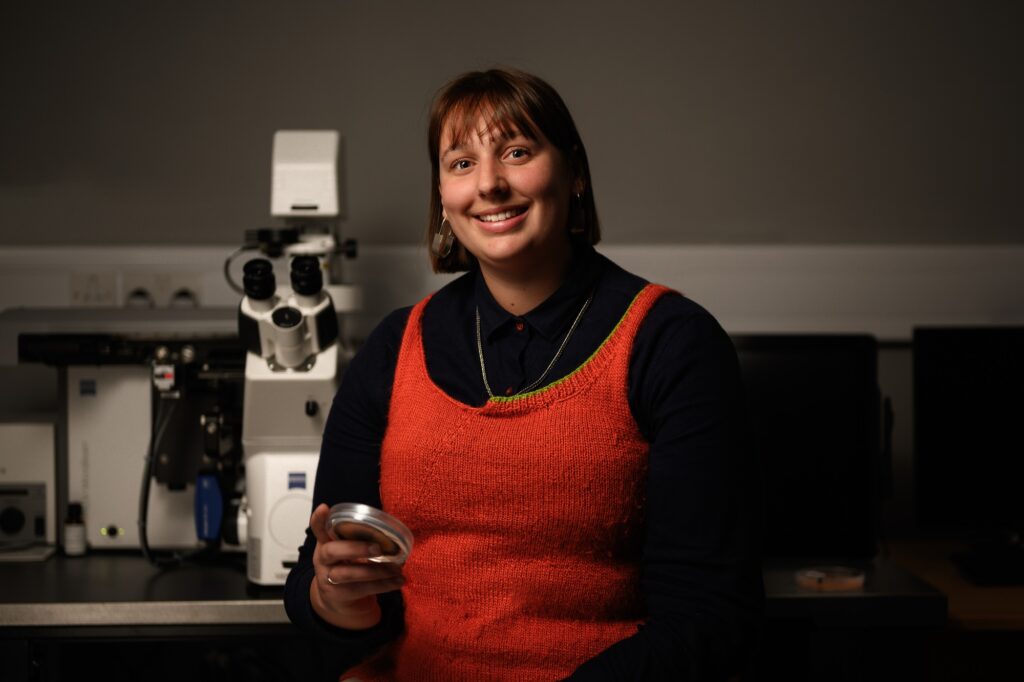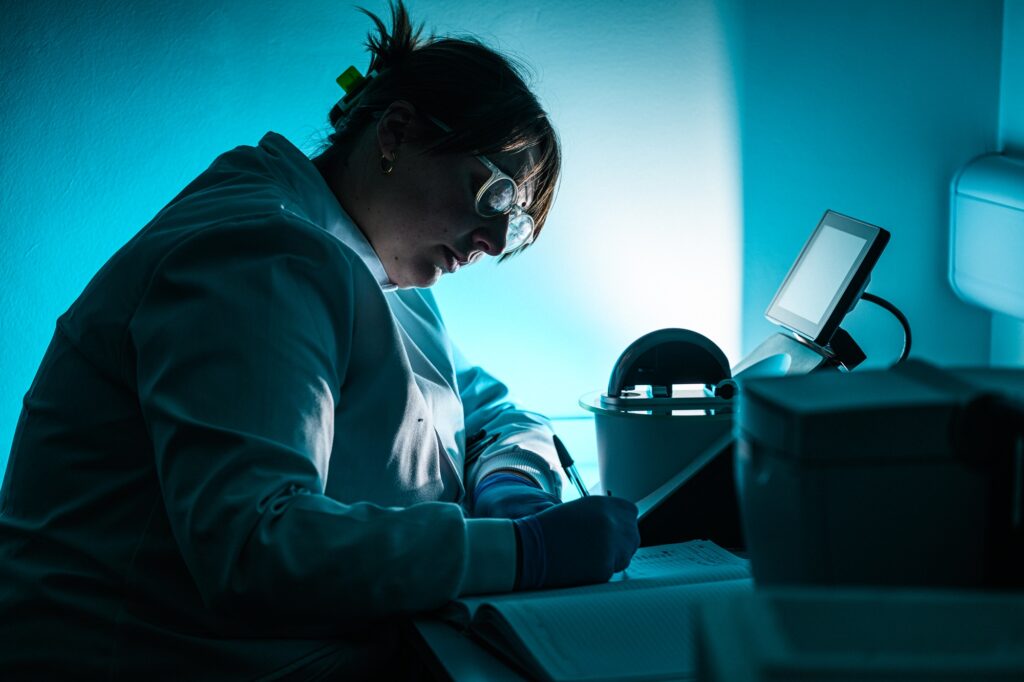Dr Cordelia Roberts is a Post-doctoral Research Assistant in Marine Microbial Ecology and Biogeochemistry, and previously completed an MRes and PhD at the Marine Biological Association (MBA).

As a researcher Cordelia is interested in looking at dead, dying and faecal material in the ocean (similar to leaf litter on land) which form sinking and suspended particles. These particles are a habitat and food source for microscopic organisms, and the interactions that take between microbes and their home/food play a crucial role in cycling carbon in the ocean.
Cordelia uses sea-going fieldwork combined with experiments, biogeochemical measurements, molecular and computational biology to understand the diversity of microbes including bacteria, archaea, and microbial eukaryotes (unicellular organisms and fungi), found on particles from the coastal environment to the polar ocean and uncover what factors drive the diversity of particles and microbes we find in the ocean.
Cordelia also provides support to Masters and PhD students working with microbiome data including sponge and diatom (microalgae) associated bacteria and sediment-dwelling fungi. In Cordelia’s current research group, she also provides support in processing biogeochemical data – looking at how biology, chemistry and geology contribute to shaping the composition of the nutrients available to organisms in the marine environment.
Why study microscopic particles?
There is a wide variety of particles which exist in the ocean, but much of the research on particles doesn’t select for the different types of particles we find, and groups them all together when sampling into one big brown mulsh of organic material. This means when we ask the questions like ‘which microbes are there?’ and ‘what are they doing?’ , we’re likely missing a lot of what is really going on underwater since we don’t necessarily know which microbes live on- and degrade which particles and how they might impact carbon cycling in different ways.
My research looks at the variety of microscopic particles and their understudied associated fungal communities found in Plymouth Sound and further afield at the long-term monitoring site ‘Station L4’.
I have also been looking at how and why the particles and the fungi who find their home on particles change from season to season. This work will hopefully lead the way in understanding fungal-particle interactions and their role in cycling carbon in the coastal ocean, encourage the research community to consider the variability we find under the waves and initiate conversations on how we can include this within models which describe the ocean’s role in carbon cycling now and predict its role in the future.
What is aquatic fungi and why it is important?
Fungi found in water are an especially understudied component of the microbial eukaryotes living in aquatic ecosystems. A type of zoosporic fungi, Chytrids, can be both parasitic and saprotrophic, meaning they can live of living and dead organic material and play an important role in cycling carbon. Since aquatic bacteria also play a similar role there is likely an interaction between the two but at the time this had not been well characterised.
What did you discover?
During work completed in my Masters I was able to show that the diversity of bacteria found on particles when chytrids are present increases, and proposed that chytrids produce a pool of public goods that allow bacteria that would otherwise be unable to breakdown this material to flourish on the particles. This is important as it shows that chytrids and potentially other aquatic fungi may play a role in regulating bacteria and their subsequent carbon cycling potential which had not previously been considered at this time.

What are microbial eukaryotes?
Microbial eukaryotes are a highly diverse group of organisms in the marine environment, but they are incredibly understudied, meaning we don’t fully understand the role they play in our oceans.
Previous research uses tools such as DNA sequencing which can tell us which organisms are there, but not necessarily which are ‘active’, dormant or dead. During my PhD, I was able to show how the activity and diversity of microbial eukaryotes associated with sinking particles changes across time and space in the Southern Ocean, a region of the ocean which is important in carbon cycling.
Why does this matter?
By being able to recognize this, we can determine who might be the major players in forming these particles (dying) and those breaking down the particles (active) which can help us to better inform models needed to map how the ocean cycles carbon now and in the future in our changing ocean.
What are the next steps in your career?
I am joining Imperial College London as a postdoctoral researcher in Marine Biogeochemistry as part of the BIO-Carbon programme project PARTITRICS. I am looking at how different particle types (sinking particles and faecal pellets) play a role in the rate of microbial respiration in the North Atlantic. Marine microbes convert organic carbon in particles to carbon dioxide (CO2) during respiration where it is either stored (sequestered) or lost to the atmosphere, meaning they play an important role in setting atmospheric concentrations of CO2. I will be taking part in a research cruise for 6 weeks to the North Atlantic to conduct fieldwork and experiments to understand how different particle types control microbial respiration in the surface ocean and down to 1000 m, in a depth region of the ocean called the ‘Twilight Zone’.
“Microbes are especially misunderstood and their importance can be forgotten by many, but microbes which live in our ocean are hugely diverse, beautiful and play a huge role in shaping how our earth and ocean looks today. Without them, life on earth would not be as we know it!”
Read Cordelia’s paper on particulate organic matter and its interactions with aquatic fungi and bacteria: https://royalsocietypublishing.org/doi/full/10.1098/rsbl.2020.0368